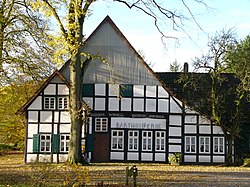Barthold pitcher
| Bartholdkrug Lipper range | |
|---|---|
 Bartholdkrug restaurant |
|
| Data | |
| place | Lip line |
| Construction year | 1713 |
| Coordinates | 51 ° 56 '44.9 " N , 8 ° 38' 14.5" E |
| particularities | |
| Listed as a historical monument | |
The Bartholdskrug is a listed secular building in Lipperzeile , a district of Oerlinghausen in the Lippe district ( North Rhine-Westphalia ). The half-timbered house is registered with the number 50 as an architectural monument in the municipal monument list. The inn, surrounded by old oaks and linden trees, is located on Hellweg in Lipperzeile. The lintel bar above the house entrance bears the inscription: Cord Henrich Grote and his wife Catrina Barkhausen had the house built before their son Barthold in 1713 . Since then the restaurant has been called Bartholdskrug .
history
The Bartholdskrug is located on the former Hellweg, a trade and military road leading from Friesland via Osnabrück , Bielefeld and Paderborn to Kassel . It crossed the then almost deserted Senne between Bielefeld and Paderborn. When the princes in the Middle Ages had more and more precisely defined the boundaries of their domain, the Lippe counts received the right to raise customs duties. As a result, customs stations were set up at the border crossings to County Lippe . Around 1713, Cord Barthold Grote became the lordly customs administrator and also offered accommodation and food for travelers. At that time the goods were transported over the Hellweg in two-wheeled carts, which the traders parked in long rows in front of the Bartholdkrug at night.
The jug experienced its best time when the movement of goods to Ravensberg came to a standstill due to tightened customs barriers. At that time, the Bartholdkrug developed into a well-known smuggler's meeting point , through which the smugglers brought valuable colonial goods to Prussia in the dark . The smuggled goods came from Bremen up the Weser to Erder , the Weser port in Lippe. From there it was secretly made to the Senne in the south-west of Lippe and across the border via the Bartholdkrug. When Lippe joined the Customs Union in 1842 , the smuggling business came to an end and the jug became a normal restaurant in the Senne again.
literature
- City of Oerlinghausen (Ed.): Oerlinghausen - history and stories: Customs and smuggling , pages 99-102, 1984.
- Gemeindeverwaltung Lipperzeile (ed.): From the history of the village , recorded by Paul Stecker, 1968.